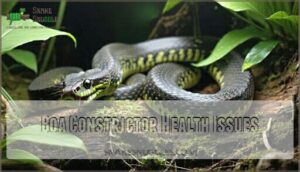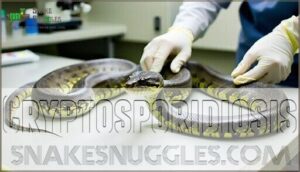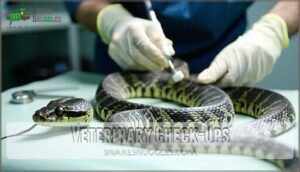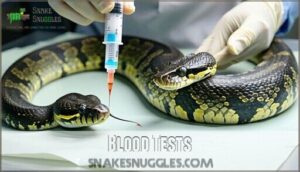This site is supported by our readers. We may earn a commission, at no cost to you, if you purchase through links.
 Boa constrictors can develop health issues that sneak up on you if you’re not careful.
Boa constrictors can develop health issues that sneak up on you if you’re not careful.
Chronic regurgitation might mean their diet or habitat needs adjusting, while intestinal blockages, often caused by eating something they shouldn’t, can be life-threatening.
Watch for wheezing or mucus, which could signal a respiratory infection, or parasites, like mites and worms, that sap their energy.
Stomatitis, or mouth rot, is another common problem, as is Inclusion Body Disease—a serious viral condition.
Regular check-ups, clean enclosures, and proper feeding habits are your snake’s best defense.
Keep an eye out; sometimes, it’s the subtle signs that matter most, and proper feeding habits can make a significant difference.
Table Of Contents
- Key Takeaways
- Boa Constrictor Health Issues
- Common Health Problems
- Diagnosing Health Issues
- Treating Health Issues
- Preventing Health Issues
- Frequently Asked Questions (FAQs)
- What illness do boa constrictors have?
- What are the first signs of IBD in boas?
- How to tell if a boa is dehydrated?
- Are boa constrictors prone to diseases?
- Do boas have health problems?
- Are boa constrictors healthy?
- Are Boa constrictor bites dangerous?
- Can a boa constrictor get AIDS?
- Can a boa constrictor cause a respiratory infection?
- What illnesses do boa constrictors get?
- Conclusion
Key Takeaways
- Keep your boa’s enclosure clean, maintain the right temperature and humidity, and avoid improper substrates to prevent infections and blockages.
- Watch for signs like regurgitation, wheezing, drooling, or lethargy, as they often signal serious health problems needing a vet’s attention.
- Regular vet check-ups, fecal exams, and blood tests can help catch hidden issues like parasites or diseases like IBD early.
- Feed the right-sized prey on a consistent schedule and avoid handling your boa too soon after meals to reduce stress and digestive issues.
Boa Constrictor Health Issues

You’ll need to recognize the warning signs of common boa constrictor health problems before they become life-threatening conditions.
Your vigilance in monitoring for symptoms like regurgitation, respiratory distress, mouth infections, and parasite indicators can make the difference between a thriving pet and a medical emergency, by being alert to these warning signs.
Chronic Regurgitation
Your boa’s distressing regurgitation episodes often signal an underlying health concern. This condition primarily affects young and wild-caught boas, leading to dangerous fluid and electrolyte losses 3-5 days after feeding.
Key regurgitation causes include:
- Improper temperature regulation in the enclosure
- Oversized prey or feeding too frequently
- Excessive handling causing stress
- Possible infectious diseases requiring veterinary attention
You’ll need to adjust feeding management and environmental factors to prevent this potentially fatal digestive issue, and address the underlying causes to ensure your boa’s well-being and prevent future regurgitation episodes.
Intestinal Blockages
While chronic regurgitation affects the upper digestive tract, another silent killer lurks further down the line: intestinal blockages. Your boa’s digestive system can become completely obstructed by substrate particles or oversized prey.
A clean enclosure is essential for preventing parasitic and fungal issues.
| Impaction Causes | Blockage Symptoms | Treatment Options |
|---|---|---|
| Indigestible bedding | Bloating & lethargy | Veterinary surgery |
| Oversized prey | Lack of appetite | Supportive hydration |
| Foreign objects | Visible distention | Manual extraction |
| Constipation | No bowel movements | Warm soaking |
You’ll need prompt veterinary care for boa digestive issues like these, as impaction often requires surgical intervention.
Respiratory Infections
While intestinal blockages affect your boa’s digestive system, respiratory infections can be equally dangerous.
Bacterial pneumonia, fungal infections, and viral causes often stem from improper humidity levels in your enclosure.
Watch for symptoms like wheezing, bubbling around the mouth, and open-mouth breathing.
Snake respiratory infection treatment typically involves antibiotics and correcting environmental conditions.
Don’t wait – respiratory problems can quickly become life-threatening if left untreated.
Parasites and Infections
While respiratory issues affect breathing, your boa’s health faces another silent threat.
Parasites and infections can wreak havoc internally without obvious signs. Protozoal parasites often cause weight loss despite regular feeding. Bacterial overgrowth may lead to skin infections, while fungal infection symptoms include unusual shedding patterns.
Viral diseases like IBD can be devastating. Preventative measures include regular fecal exams and maintaining proper hygiene.
Prompt boa parasite treatment is essential when parasitic infections are detected, and it is crucial to address these issues to prevent further complications, ensuring the overall health and well-being of your boa, which can be supported by regular fecal exams and good hygiene.
Common Health Problems
You’ll need to recognize the warning signs of common boa health problems, including stomatitis, inclusion body disease, cryptosporidiosis, and parasitic infections, before they become life-threatening.
Even the most attentive owners can miss these subtle symptoms, which is why regular veterinary check-ups, proper housing conditions, and careful observation during handling are your best defenses against these silent killers, including parasitic infections.
Stomatitis
After addressing major health conditions, let’s examine another serious threat lurking in your snake’s mouth. Stomatitis (mouth rot) is an infectious, purulent process destroying your boa’s gums, often accompanied by systemic bacterial infections.
Watch for these early signs of infectious stomatitis:
- Reddened, swollen gums with cheesy discharge
- Reluctance to eat or frequent dropping of prey
- Keeping mouth partially open or excessive saliva
Early detection requires regular oral exams. Treatment includes antibiotic therapy and gentle cleaning with hydrogen peroxide to address the infectious process.
Inclusion Body Disease
Lurking silently among captive collections, Inclusion Body Disease (IBD) represents one of the most devastating health threats your boa constrictor may face.
This highly contagious reptarenavirus spreads through direct contact and poor sanitation, manifesting as neurological signs like head tremors and uneven pupils.
While boas can be asymptomatic carriers, IBD remains universally fatal without treatment options.
Regular blood tests during quarantine periods are your best defense against this silent killer.
In addition, weakened immunity can make snakes susceptible to bacterial bloodstream infections.
Cryptosporidiosis
A silent but deadly protozoal parasite, cryptosporidiosis has become increasingly common in captive boa constrictors. This condition causes devastating gastric disease with no proven cure.
Watch for these key crypto symptoms:
- Mid-body swelling creating a firm bulge in the stomach area
- Persistent weight loss despite regular feeding
- Regurgitation or diarrhea depending on infection location
Diagnosis requires fecal analysis by an experienced reptile veterinarian. While treatments like paromomycin show promise, prevention through quarantine remains your best defense.
Helminths and Protozoa
While cryptosporidiosis affects digestion, your boa may face other internal threats.
Helminths (like nematodes and cestodes) and protozoa (including amoebas) can silently damage your snake’s health. These parasites often cause poor digestion and weight loss despite regular feeding.
You’ll need regular fecal analysis to detect these invaders.
When diagnosed, implement proper deworming strategies with medications like Fenbendazole for helminth prevention and Metronidazole for protozoal infections.
Some parasites develop resistance, so veterinary guidance is essential.
Diagnosing Health Issues
You’ll need to recognize the subtle signs of illness in your boa constrictor before they develop into life-threatening conditions.
Early detection through regular veterinary check-ups, fecal exams, and observation of behavioral changes can make the difference between simple treatment and losing your scaly companion, which is why early detection is crucial.
Veterinary Check-Ups
Regular veterinary check-ups are your boa’s first line of defense against hidden health problems.
Regular vet visits can uncover hidden health threats early, ensuring your boa thrives with a long, healthy life.
Schedule annual examinations with a reptile specialist who can spot issues before they become serious. These visits typically include weight monitoring, physical assessment, and expert advice on husbandry.
Early detection of boa constrictor health issues through professional evaluation saves lives—many snake health problems are treatable when caught early.
Don’t wait until your boa shows symptoms; prevention beats treatment every time, as it allows for treatment to be more effective.
Fecal Exams
Fecal exams provide a window into your boa’s digestive health.
You’ll need to collect a fresh sample of feces (ideally within 24 hours) for microscopic analysis.
Your vet will examine it for nematodes, amoebas, protozoa like Entamoeba invadens, and signs of bacterial overgrowth.
Regular parasite identification through feces analysis can catch issues before your snake shows symptoms, making treatment faster and more effective.
You can find products for boa fecal exams online.
Blood Tests
Diving into your boa’s bloodstream reveals vital health insights that might otherwise remain hidden.
Blood tests provide invaluable diagnostic information through complete blood counts and plasma chemistry analysis. You’ll gain visibility into electrolyte imbalances, organ function, and infection markers that could indicate serious conditions like IBD.
Established reference values for captive B. constrictors help veterinarians interpret results accurately, making lab analysis an essential component of proactive boa constrictor health care.
Early diagnosis is key to addressing reptile disease symptoms effectively.
Imaging Studies
When blood tests alone aren’t enough to pinpoint your boa’s health issues, veterinarians often turn to imaging studies.
These advanced diagnostic tools reveal what’s happening inside your snake without invasive procedures.
- X-ray imaging shows bone structures and can identify foreign bodies or intestinal blockages
- Ultrasound scans visualize soft tissues and internal organs in real-time
- CT scans provide detailed cross-sectional views for complex cases
- MRI usage, though less common, offers superior soft tissue contrast for complex cases and provides detailed cross-sectional views with superior soft tissue.
Treating Health Issues
You’ll need to act quickly when your boa shows symptoms, as prompt treatment dramatically increases recovery chances.
With proper antibiotics, antiparasitic medications, supportive care techniques, and sometimes surgical intervention, many conditions that would otherwise be fatal can be successfully managed at home or with veterinary assistance.
Antibiotics
When your boa constrictor falls ill from bacterial infections, antibiotics can be the difference between life and death.
You’ll need a proper veterinary prescription to guarantee effective antibiotic therapy.
| Antibiotic Type | Common Use | Dosage Calculation | Injection Sites | Potential Side Effects |
|---|---|---|---|---|
| Enrofloxacin | Respiratory | 5-10 mg/kg | Subcutaneous | Appetite loss |
| Ceftazidime | Severe infections | 20 mg/kg | Intramuscular | Regurgitation |
| Amikacin | Resistant strains | Based on weight | Subcutaneous | Kidney issues |
| Metronidazole | Anaerobic bacteria | 20-40 mg/kg | Oral | Neurological symptoms |
| Chloramphenicol | Stomatitis | 50 mg/kg | Oral/Injectable | Decreased appetite |
Never attempt prophylactic use without veterinary guidance as antibiotic resistance can develop.
Antiparasitic Medications
While antibiotics target bacterial infections, your boa might need targeted weapons against tiny invaders living in its gut.
Antiparasitic medications are key to eliminating these unwelcome guests.
For effective parasite eradication, consider these treatments:
- Fenbendazole (Panacur) for nematodes, typically at 50-100 mg/kg dosage
- Praziquantel for tapeworms and flukes
- Metronidazole against stubborn amoebas, with care to prevent metronidazole resistance
Always follow your vet’s instructions for preventative treatments and accurate dosing to ensure the well-being of your boa.
Supportive Care
While antiparasitic medications target specific invaders, supportive care addresses your boa’s overall well-being during illness.
Fluid therapy and electrolyte balance management are often necessary when your snake isn’t eating or drinking properly. Wound management requires careful cleaning and sometimes specialized dressings.
Nutritional support might include assist feeding or supplements. Stress reduction through proper quarantine protocols (separating sick animals) can markedly improve recovery rates.
Remember, maintaining proper pain management is just as important for reptiles as it’s for mammals, and this is crucial for overall well-being during illness, which is why proper care is essential.
Surgery
While supportive care helps many conditions, some boa health issues require surgical intervention.
When medical management isn’t enough, your snake may need a surgical procedure under proper anesthesia.
Surgical options for your boa constrictor include:
- Salivary gland cyst removal through a small neck incision
- Abscess drainage with saline flushing to prevent sepsis
- Coeliotomy for addressing reproductive complications
Post-op care includes antibiotics and wound management.
Monitor the surgical site carefully for proper healing.
Preventing Health Issues
You’ll save yourself countless sleepless nights and veterinary bills by maintaining proper housing conditions, providing a balanced diet, conducting regular health check-ups, and implementing strict quarantine procedures for new animals.
Just like human preventative healthcare, your boa’s wellness depends on your consistent attention to these fundamentals, which create a strong foundation for a long, healthy life, based on proper care.
Proper Housing
Your housing setup serves as your boa’s first line of defense against potential health problems.
Proper enclosure size maintains adequate movement, while maintaining the correct thermal gradient (80-85°F daytime with a 95°F basking spot) prevents respiratory infections.
Humidity control at 50-70% discourages skin issues, and appropriate substrate choice facilitates hygiene.
Selecting the correct boa habitat products is vital for their well-being.
Regular cleaning protocols using diluted bleach solution (1:30) eliminate pathogens that thrive in poor housing conditions, which is crucial for maintaining a healthy thermal gradient and ensuring the boa’s overall well-being.
Balanced Diet
With your perfect enclosure setup, your boa’s health now depends on what you feed them. A balanced diet prevents numerous health issues that can silently affect your snake.
Here’s what your boa needs for ideal health:
- Offer appropriate prey variety (mice for juveniles, rats or rabbits for adults) scaled to your boa’s mid-body girth
- Maintain consistent feeding schedules (weekly for juveniles, every 10-14 days for adults)
- Monitor weight regularly to prevent both obesity and underweight conditions
Providing frozen-thawed prey reduces injury risks, ensuring your boa’s overall health and well-being by following a proper diet.
Regular Check-Ups
Regular veterinary check-ups are your boa constrictor’s lifeline to detecting health issues before they become serious.
Schedule annual exams where your vet will perform Visual Inspection of scales and mouth, Weight Monitoring to track growth patterns, and assess Hydration Status.
Between visits, monitor for Behavior Changes and Shedding Issues yourself.
Even when your snake appears healthy, these preventative appointments can catch silent problems that aren’t yet showing symptoms.
Accurate readings from a reptile environment monitor are also essential for maintaining ideal health and ensuring the overall well-being of your boa constrictor through preventative appointments.
Quarantine Procedures
Every new boa’s arrival should trigger your quarantine protocols immediately.
Keep newcomers isolated for 60-90 days in separate rooms with dedicated tools and supplies.
This isolation environment prevents disease spread to your existing collection.
During quarantine, maintain strict hygiene protocols, monitor for health issues, and reduce stress by providing appropriate hiding spots.
Effective biosecurity measures include washing hands between handling different snakes and disinfecting all equipment regularly – these simple steps offer powerful disease control, which is a key part of disease control.
Frequently Asked Questions (FAQs)
What illness do boa constrictors have?
Boa constrictors can face illnesses like respiratory infections, intestinal parasites, and mouth rot.
These result from poor housing conditions, diet issues, or infections.
Watch for symptoms like regurgitation, swelling, or lethargy, and seek veterinary help.
What are the first signs of IBD in boas?
Think of IBD like a thief in the night; it sneaks in with subtle clues.
Early signs include muscle tremors, unnatural posture, difficulty moving, and regurgitation.
If you notice these, consult a vet immediately.
How to tell if a boa is dehydrated?
Watch for wrinkled skin, sunken eyes, or slow skin elasticity recovery when gently pinched.
A dehydrated boa might also exhibit lethargy and reduced appetite.
Make certain proper humidity, hydration, and consult a vet if symptoms persist.
Are boa constrictors prone to diseases?
Yes, boa constrictors are prone to diseases like mouth rot, respiratory infections, and parasites.
With proper care—clean enclosures, correct temperatures, and regular vet checks—you can keep your boa healthy and thriving.
Do boas have health problems?
Like an engine needing tune-ups, boas face health challenges like infections, parasites, and digestive issues.
Proper housing, diet, and hygiene keep them thriving.
Catch problems early—with care, you’ll keep your boa healthy and happy!
Are boa constrictors healthy?
Boa constrictors are generally healthy if housed properly, but they’re susceptible to issues like parasites, infections, and digestive problems.
Maintaining proper enclosure conditions, feeding habits, and hygiene is essential to keeping them thriving.
Are Boa constrictor bites dangerous?
A boa constrictor can exert over 4,000 pounds of pressure per square inch, but its bite rarely causes major harm.
While painful and prone to infection, it’s not venomous. Cleaning promptly minimizes health risks.
Can a boa constrictor get AIDS?
A boa constrictor can’t get AIDS like humans; their immune systems and viruses differ.
However, boas can suffer from other serious illnesses like Inclusion Body Disease (IBD), which weakens their health similar to how HIV affects us.
Can a boa constrictor cause a respiratory infection?
Snakes like boa constrictors can carry bacteria or parasites that may trigger respiratory infections in humans, especially if hygiene is poor.
Always wash your hands and clean enclosures thoroughly to minimize risks. Prevention’s key!
What illnesses do boa constrictors get?
Your scaly friend can face health issues like respiratory infections, mouth rot, parasites, regurgitation, and intestinal problems.
Keeping the enclosure clean, warm, and humid helps prevent these illnesses, but a vet visit is essential if symptoms persist, which is a key factor in maintaining your pet’s overall health.
Conclusion
Owning a boa constrictor isn’t just about reveling in their exotic allure—it’s a commitment to their health.
Boa constrictor health issues, like regurgitation, respiratory infections, or parasites, can sneak up faster than you’d think.
Maintain a clean enclosure, nail their diet, and prioritize regular check-ups to catch silent killers before they strike, and think of it this way: your vigilance keeps their slithering drama-free.
After all, healthy snakes make for much happier (and less stressed) owners.
















